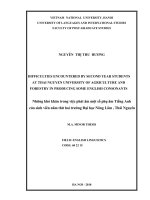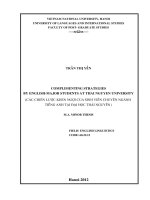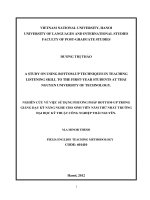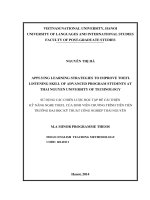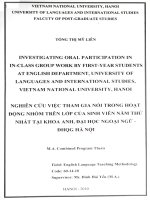The use of communication strategies in different speaking tasks by the first year students at Thai Nguyen university of agricuture and forestry
Bạn đang xem bản rút gọn của tài liệu. Xem và tải ngay bản đầy đủ của tài liệu tại đây (208.23 KB, 8 trang )
ISSN: 1859-2171
e-ISSN: 2615-9562
TNU Journal of Science and Technology
225(03): 81 - 88
THE USE OF COMMUNICATION STRATEGIES IN DIFFERENT
SPEAKING TASKS BY THE FIRST YEAR STUDENTS
AT THAI NGUYEN UNIVERSITY OF AGRICUTURE AND FORESTRY
Vu Kieu Hanh
TNU - University of Agriculture and Forestry
ABSTRACT
This study aims to investigate the use of communication strategies by the first-year students at Thai
Nguyen University of Agriculture and Forestry (TUAF) while performing one-way and two-way
speaking tasks. The participants were 30 first year students, major in Forestry. They were randomly
selected by using the convenience sampling method. Data were collected by the observation form
and transcribed data of two different tasks: a picture description task (a one-way task) and a role-play
task (a two-way task). The frequency, percentage, mean, standard deviation (SD), and Chi-square
were employed to analyze the data. The results showed that the students used all 5 main types of
communication strategies which included avoidance strategy, target language-based strategy, L1based strategy, modification devices, and nonlinguistic strategy. The most frequently used type of
communication strategies was modification devices and the least used type of communication
strategies was avoidance strategy. The findings also showed that the students used various types of
communication strategies while performing two different tasks.
Keywords: Communication; strategies; speaking; first-year students; task.
Received: 25/12/2019; Revised: 16/02/2020; Published: 21/02/2020
SỬ DỤNG CÁC CHIẾN LƯỢC GIAO TIẾP TRONG HOẠT ĐỘNG NÓI
CỦA SINH VIÊN NĂM THỨ NHẤT TRƯỜNG ĐẠI HỌC NÔNG LÂM
– ĐẠI HỌC THÁI NGUYÊN
Vũ Kiều Hạnh
Trường Đại học Nông Lâm – ĐH Thái Nguyên
TÓM TẮT
Nghiên cứu này nhằm mục đích khảo sát các chiến lược giao tiếp được sinh viên năm thứ nhất sử
dụng khi thực hiện các hoạt động nói khác nhau: hoạt động một chiều và hai chiều. Đối tượng
tham gia là 30 sinh viên năm thứ nhất tại Trường Đại học Nông Lâm – ĐH Thái Nguyên và được
lựa chọn ngẫu nhiên bằng phương pháp lấy mẫu thuận tiện. Dữ liệu được thu thập thông qua biểu
mẫu quan sát và dữ liệu được ghi chép từ hai loại hoạt động khác nhau: hoạt động mô tả hình ảnh
(hoạt động một chiều) và hoạt động đóng vai (hoạt động hai chiều). Tần suất, tỷ lệ phần trăm, giá
trị trung bình, độ lệch chuẩn (SD) và chi bình phương được sử dụng để phân tích dữ liệu. Kết quả
cho thấy các sinh viên đã sử dụng tất cả 5 loại chiến lược giao tiếp chính, bao gồm chiến lược né
tránh, chiến lược dựa trên ngôn ngữ mục tiêu, chiến lược dựa trên ngôn ngữ thứ nhất, chiến lược
sử dụng phương tiện cải biên và chiến lược phi ngôn ngữ. Chiến lược sử dụng phương tiện cải biên
được sử dụng thường xuyên nhất và chiến lược né tránh được sử dụng ít nhất. Các kết quả nghiên
cứu cũng cho thấy sinh viên sử dụng nhiều chiến lược giao tiếp khác nhau khi thực hiện hai hoạt
động nói khác nhau.
Từ khóa: Giao tiếp; chiến lược; kĩ năng nói; sinh viên năm thứ nhất; hoạt động.
Ngày nhận bài: 25/12/2019; Ngày hoàn thiện: 16/02/2020; Ngày đăng: 21/02/2020
Email:
DOI: />; Email:
81
Vu Kieu Hanh
TNU Journal of Science and Technology
225(03): 81 - 88
1. Introduction
3. Literature Review
Success in communication is essential for
people who want to communicate with other
in different countries. In order to
communicate successfully, communication
strategies are important tools because they are
the ways or techniques used to communicate
and solve communication problems. Many
researchers believe that communication
strategies can be used to solve communication
problems and enhance interaction in the target
language [1], [2]. For more than 30 years, a
considerable number of studies have been
conducted to investigate the use of
communication strategies among second and
foreign language learners of English. It is,
therefore, crucial to investigate the use of
communication strategies in order to obtain
rich insights into the complex process of
language acquisition and help learners
develop their communication skills. A review
of available literature has shown that a small
amount of research has been conducted with
language learners learning English as a
foreign language (EFL). This study aimed to
investigate types of communication strategies
employed by the students at Thai Nguyen
University of Agriculture and Forestry in
order to raise learners’ and teachers’
awareness of using these strategies. The
findings of this study can be used as
guidelines for teachers of English to teach
appropriate communication strategies to help
learners solve their communication problems
3.1. Communication Strategies
2. Research Questions
3.2. Classification of Communication Strategies
The study was designed to answer the
following two research questions:
Different types of CSs have been classified by
many researchers in the field. Selinker [7]
classified CSs into three main types including
borrowing, paraphrase and avoidance.
Tarone, Cohen & Dumas [8] classified CSs
into two main types: reduction strategies and
achievement
strategies.
In
addition,
Wannaruk [9] classified CSs into five types:
L1-based strategies, L2-based strategies,
1. What types of communication strategies
are employed by the students while doing
speaking tasks?
2. Do the students use different types of
communication strategies in one-way and
two-way tasks?
82
The term “communication strategies” (CSs)
has been used within the second language (L2)
context since the early 1970s. Dörnyei [3] is
credited for being the first to use this term to
explain certain types of errors made by L2
learners. However, Færch & Kasper [4] were
the first to recognize learners’ problemsolving behavior during teaching language as
“communication strategy.” They stated that
learners tend to use CSs to compensate for
their lack of appropriate target language
knowledge when expressing or decoding the
meaning of their intended utterances. With a
psycholinguistic framework, Færch and
Kasper defined communication strategies as
“potentially conscious plans for solving what
to an individual presents itself as a problem
in reaching a particular communication goal”
[5, p.81].
Therefore, in the most general sense
communication strategies is a plan of action
to accomplish a communication goal and the
enhancement of communication. CSs are the
strategies that are used when communication
problems occur. Although there are various
quoted definitions of CSs, “there is no
universally accepted definition of CSs” [6].
Researchers in the field seem to agree on the
fact that CSs are resorted to when learners’
linguistic means are not enough to convey
their intended meaning.
; Email:
Vu Kieu Hanh
TNU Journal of Science and Technology
nonlinguistic
strategies,
analysis-based
strategies, and control-based strategies.
Besides, Weerarak [10] proposed three main
types of CSs: avoidance or reduction
strategies, achievement or compensatory
strategies, and time-gaining strategies. Since
the classification of CSs has been
continuously developed, many different
typologies of CSs have merged. In this study,
the researcher adopted Willems [11]
classification of CSs and divided the CSs into
five main types that are avoidance strategy
(topic avoidance and message avoidance),
target
language-based
strategy
(approximation, circumlocution and direct
asking), L1-based
strategy
(language
switching and foreignizing), modification
devices (comprehension check, clarification
request, overlap, back channel, self-repair,
confirmation check and pausing) and
nonlinguistic strategy (gesture and mime).
The types of CSs used as a framework of this
study are shown in Table1.
Table 1. Types of CSs used in the study
Avoidance
strategy
1. Topic avoidance
2. Message avoidance
Target
Language-based
3. Approximation
4. Circumlocution
5. Direct asking
L1-based strategy
6. Language switching
7. Foreignizing
Modification
devices
8. Comprehension check
9. Clarification request
10. Overlap
11. Back channel
12. Self-repair
13. Confirmation
14. Pausing
Nonlinguistic
strategy
15. Gesture
16. Mime
; Email:
225(03): 81 - 88
4. Methodology
A convenience sampling technique was used
to select the participants for this study. The
participants consisted of 30 first year students
at TUAF. At the time of data collection, all of
them enrolled in two English courses: Basic
Oral Skill and Conversation courses. In those
two courses, they learn how to communicate
in
different
situations
in
real-life
circumstances with English native speakers.
The instruments used to collect data in this
study were the observation form and
transcribed data of two different tasks: a
picture description task (one-way task) and a
role-play task (two-way task). The
observation form was modified from
Bialystok [1] based on the theoretical
frameworks proposed by Chen [2] and
Dörnyei [3].
For the purpose of this study, the participants
were asked to perform the two different
speaking tasks. The researcher used the
observation form to check the types of CSs
used by the students while performing the two
different tasks. Then, the frequency and
percentage of students’ use of CSs checked in
the observation form were analyzed. To check
for reliability, the researcher and one expert
independently checked the types of CSs used
by the students. The level of agreement in
checking the types of CSs in the observation
form was then computed in order to check for
reliability. To check the data collected from
the observation form, the video and audio
recordings of the students’ task performance
were transcribed. Then the researcher and the
same expert independently coded all
transcribed data from the two different tasks.
After that, the frequency and percentage of
students’ use of CSs coded from the
transcribed data were analyzed.
83
Vu Kieu Hanh
TNU Journal of Science and Technology
225(03): 81 - 88
5. Findings
Table 2. Types of CSs used by the students in the picture description or one-way task
Types of Communication Strategies
Avoidance strategy
1. Topic avoidance
2. Message avoidance
Target Language-based strategy
3. Approximation
4. Circumlocution
5. Direct asking
L1-based strategy
6. Language switching
7. Foreignizing
Modification devices
8. Comprehension check
9. Clarification request
10. Overlap
11. Back channel
12. Self-repair
13. Confirmation
14. Pausing
Nonlinguistic strategy
15. Gesture
16. Mime
Total
Observation form
frequency
%
3
0.84
0
0
3
0.84
9
2.52
5
1.40
4
1.12
0
0
5
1.40
5
1.40
0
0
309
86.55
0
0
0
0
0
0
0
0
60
16.80
0
0
249
69.75
31
8.68
31
8.68
0
0
357
100
As shown in Table 2, 7 subtypes of CSs were
checked in the observation form while the
students performed the picture description or
one-way task. Pausing (249, 69.75%) was
mostly observed in the picture description task
(one-way task), followed by self-repair (60,
16.80%), gesture (31, 8.68%), approximation
(5, 1.40%), language switching (5, 1.40%), and
circumlocution (4, 1.12%). The least
frequently used strategy was message
avoidance (3, 0.84%). For the five main types
of CSs, the findings showed that modification
devices was mostly used by the students (309,
86.55%), followed by nonlinguistic strategy
(31, 8.68%), target language based strategy (9,
2.52%) and L1-based strategy (5, 1.40%).
Avoidance strategy was the least frequently
used strategy (3, 0.84%).
In terms of the transcribed data, the findings
showed that the most frequently used strategy
was pausing (255, 69.29%), followed by self84
Transcription Data
frequency
%
3
0.82
0
0
3
0.82
9
2.45
5
1.36
4
1.09
0
0
5
1.36
5
1.36
0
0
318
86.41
0
0
0
0
0
0
0
0
63
17.12
0
0
255
19.29
33
8.97
33
8.97
0
0
368
100
repair (63, 17.12%), gesture (33, 8.97%),
approximation (5, 1.36%), language switching
(5, 1.36%), and circumlocution (4, 1.09%).
The least frequently used strategy was message
avoidance (3, 0.82%). For the five main types
of CSs, the findings showed that modification
devices were mostly used by the students (318,
86.41%), followed by nonlinguistic strategy
(33, 8.97%), target language-based strategy (9,
2.45%) and L1-based strategy (5, 1.36%).
Avoidance strategy was the least frequently
used strategy (3, 0.82%).
In order to elicit the students’ use of CSs in
the role-play or two-way task, the students
were asked to play in the simulated business
situation. The researcher and one expert
independently checked the types of CSs used
by the students in the observation form and
the transcribed data. The frequency of the
students’ use of CSs in the observation form
and the transcribed data was counted.
; Email:
Vu Kieu Hanh
TNU Journal of Science and Technology
225(03): 81 - 88
Table 3. Types of CSs used by the students in the role-play or two-way task
Types of Communication Strategies
Avoidance strategy
1. Topic avoidance
2. Message avoidance
Target Language-based strategy
3. Approximation
4. Circumlocution
5. Direct asking
L1-based strategy
6. Language switching
7. Foreignizing
Modification devices
8. Comprehension check
9. Clarification request
10. Overlap
11. Back channel
12. Self-repair
13. Confirmation
14. Pausing
Nonlinguistic strategy
15. Gesture
16. Mime
Total
Observation form
frequency
%
0
0
0
0
0
0
2
0.46
2
0.46
0
0
0
0
5
1.40
5
1.40
0
0
309
86.55
0
0
0
0
0
0
0
0
60
16.80
0
0
249
69.75
31
8.68
31
8.68
0
0
357
100
Table 3 showed that 10 subtypes of CSs were
checked in the observation form while the
students performed the role-play task (two-way
task). Pausing (233, 53.81%) was mostly used
by the students, followed by self-repair (64,
14.78%), gesture (44, 10.16%), back channel
(30, 6.93%), confirmation (25, 5.77%),
language
switching
(16,
3.70%),
comprehension
check
(12,
2.77%),
clarification request (5, 1.15%), approximation
(2, 0.46%) and overlap (2, 0.46%). The results
also showed that the students used 4 main
types of CSs. Modification devices were the
main type of CSs that was mostly used by the
students (371, 85.68%), followed by nonlinguistic strategy (44, 10.16%), L1-based
strategy (16, 3.70%), and target languagebased strategy (2, 0.46%).
; Email:
Transcription Data
frequency
%
0
0
0
0
0
0
2
0.45
2
0.45
0
0
0
0
5
1.36
5
1.36
0
0
318
86.41
0
0
0
0
0
0
0
0
63
17.12
0
0
255
19.29
33
8.97
33
8.97
0
0
368
100
In terms of the transcribed data, the findings
showed that the students used 10 subtypes of
CSs. The most frequently used strategy was
pausing (239, 53.47%), followed by self-repair
(66, 14.77%), gesture (46, 10.29%), back
channel (30, 6.71%), confirmation (27, 6.04%),
language switching (16, 3.58%), comprehension
check (12, 2.68%), clarification request (5,
1.12%), overlap (4, 0.89), and approximation
(2, 0.45%). Moreover, the results showed 4
main types of CSs that were employed by the
students. Modification devices were mostly
used by the students (383, 85.68%), followed by
non-linguistic strategy (46, 10.29%), L1-based
strategy (16, 3.58%), and target language-based
strategy, (2, 0.45%). However, avoidance
strategy was not used by the students.
85
Vu Kieu Hanh
TNU Journal of Science and Technology
225(03): 81 - 88
Table 4. The comparison of the frequency and percentage of types of CSs used by the students
in both picture description task and role play task
Types of Communication Strategies
Avoidance strategy
1. Topic avoidance
2. Message avoidance
Target Language-based strategy
3. Approximation
4. Circumlocution
5. Direct asking
L1-based strategy
6. Language switching
7. Foreignizing
Modification devices
8. Comprehension check
9. Clarification request
10. Overlap
11. Back channel
12. Self-repair
13. Confirmation
14. Pausing
Nonlinguistic strategy
15. Gesture
16. Mime
Total
Observation form
frequency
%
3
0.38
0
0
3
0.38
11
1.39
7
0.87
4
0/51
0
0
21
2.66
21
2.66
0
0
680
86.08
12
1.52
5
0.63
2
0.25
30
3.78
124
15.70
25
3.16
482
61.01
75
9.49
75
9.49
0
0
790
100
As can be seen in table 4, the comparison of
the frequency and percentage of types of CSs
used by the students while performing both
one-way and two-way tasks. 12 subtypes of
CSs were observed in both one-way and twoway tasks. The most frequently used strategy
was pausing (482, 61.01%), followed by selfrepair (124, 15.70%), gesture (75, 9.49%),
back channel (30, 3.78%), confirmation (25,
3.16%), language switching (21, 2.66%),
comprehension
check
(12,
1.52%),
approximation (7, 0.87%), clarification
request (5, 0.63%), circumlocution (4,
0.51%), and message avoidance (3, 0.38%).
The least frequently used strategy was overlap
(2, 0.25%). However, topic avoidance, direct
asking, foreignizing, and mime were not
observed in both tasks. In terms of 5 main
types of CSs, the findings showed that the
students used all 5 main types of CSs. The
students mostly used modification devices
86
Transcription Data
frequency
%
3
0.37
0
0
3
0.37
11
1.35
7
0.86
4
0.49
0
0
21
2.58
21
2.58
0
0
701
86.01
12
1.47
5
0.61
4
0.49
30
3.68
129
15.83
27
3.31
494
60.61
79
9.69
79
9.69
0
0
815
100
(680, 86.08%), followed by nonlinguistic
strategy (75, 9.49%), L1-based strategy (21,
2.66%), target language-based strategy (11,
1.39%), and avoidance strategy (3, 0.38%).
In terms of the transcribed data, the findings
showed that 12 subtypes of CSs were
employed by the students in both one-way
and two-way tasks. The most frequently used
strategy was pausing (494, 60.61%), followed
by self-repair (129, 15.83%), gesture (79,
9.69%), back channel (30, 3.68%),
confirmation (27, 3.31%), language switching
(21, 2.58%), comprehension check (12,
1.47%),
approximation
(7,
0.86%),
clarification
request
(5,
0.61%),
circumlocution (4, 0.49%) and overlap (4,
0.49%). The least frequently used strategy
was message avoidance (3, 0.37%).
Moreover, the results showed that 4 CSs that
were topic avoidance, direct asking,
foreignizing, and mime were not used by the
; Email:
Vu Kieu Hanh
TNU Journal of Science and Technology
225(03): 81 - 88
students. The results also showed that all 5 main types were employed by the students. The most
frequently used strategy was modification devices (680, 86.08%), followed by non-linguistic
strategy (75, 9.49%), L1-based strategy (21, 2.66%), target language-based strategy (11, 1.39%),
and avoidance strategy (3, 0.38%).
Table 5. The Chi-square test of the types of CSs used by the students in the observation form
Value
Pearson Chi-Square
Likelihood Ratio
Linear-by-Linear Association
df
4
4
1
15.195a
17.036
2.643
N of Valid Cases
Asymptotic Significance (2-sided)
.004
.002
.105
790
In Table 5, the Chi-square test was used to examine the difference in the types of CSs used in
one-way and two-way tasks checked in the observation form. The findings showed that there was
a significant difference between the students’ use of types of CSs in both one-way and two-way
tasks (.04)
Table 6. The Chi-square test of the types of CSs used by the students in the transcribed data
Value
Pear Pearson Chi-Square
Likelihood Ratio
Linear-by-Linear Association
N of Valid Cases
13.855a
15.552
2.969
815
As can be seen in Table 6, the Chi-square test
was used to examine the difference in the
types of CSs used in one-way and two-way
tasks coded from the transcribed data. The
findings showed that there was a significant
difference between the students’ use of types
of CSs in both the one-way and two-way
tasks (.008).
6. Conclusion
In the present study, different CSs were used
in different speaking tasks. Modification
devices were the main type of CSs that was
mostly employed by the participants in both
one-way task (picture description) and twoway task (role- play). Among 16 subtypes of
CSs, pausing was the most frequently used
strategy. However, 4 subtypes of CSs that
were topic avoidance, direct asking,
foreignizing, and mime were not employed by
the students in this study. The findings also
showed that the students used various types of
communication strategies while performing
two different tasks.
; Email:
df
4
4
1
Asymptotic Significance (2-sided)
.008
.004
.005
REFERENCES
[1]. E. Bialystok, Communication strategies: A
psychological analysis of second language
use. London: Blackwell, 1990.
[2]. S. Q. Chen, “A study of communication
strategies in interlanguage production by
Chinese EFL Learners,” Language Learning,
vol. 40(2), pp. 155-187, 1990.
[3]. Z. Dörnyei, “On the teachability of
communication strategies,” TESOL Quarterly,
vol. 29(01), pp. 55-85, 1995.
[4]. C. Færch and G. Kasper, “Two ways of
defining
communication
strategies”.
Language Learning, Vol 34(01), pp. 45-63,
1984.
[5]. L. Ghout-Khenoune, “The Effects of Task
Type on Learners’ use of Communication
Strategies”, Procedia-Social and Behavioral
Sciences, vol. 69, pp. 770-779, 2012.
[6]. T. Paribakht, “Strategic Competence and
Language Proficiency,” Applied Linguistics,
vol. 6(2), pp. 132–146, 1985.
[7]. L.
Selinker,
“Interlanguage”,
IRALInternational Review of Applied Linguistics in
Language Teaching, vol. 10, pp. 209-241, 1972.
87
Vu Kieu Hanh
TNU Journal of Science and Technology
[8]. E. Tarone, A. Cohen, and G. Dumas, “A
closer
look
at
some
interlanguage
terminology: a framework for communication
strategies,” Working Papers on Bilingualism,
No.9, pp. 76-90, 1976.
[9]. A. Wannaruk, Case Study Research:
Investigation of Communication Strategies
Used by College Students at Suranaree
University of Technology on Language Tasks,
Nakhon Ratchasima, Thailand, 2010.
88
225(03): 81 - 88
[10].
L. Weerarak, Oral communication
strategies employed by English major taking
listening and speaking 1 at Rajabhat Institute
Nakhon Ratchasima, Unpublished Master’s
Thesis. Suranaree University of Technology,
Nakhon Ratchasima, Thailand, 2003.
[11].
G. M. Willems, “Communication
strategies and their significance in foreign
language teaching,” System, vol. 15(3), pp.
351-364, 1987.
; Email:



